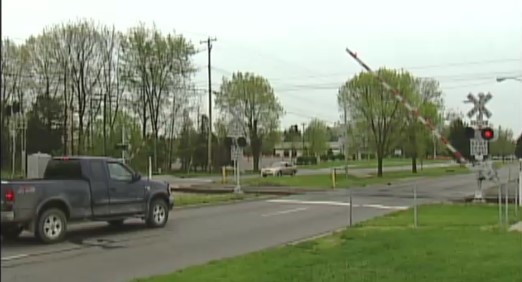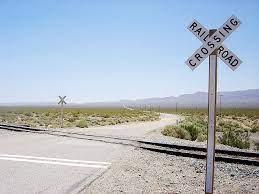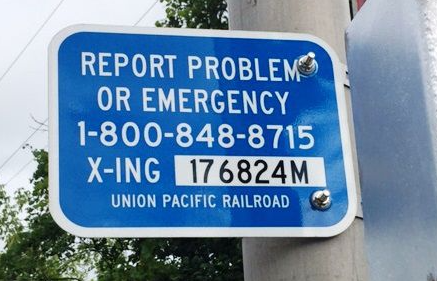Lesson Eight: Railroad Crossings (6.8)
Like semi-trucks, trains are an important part of our economy and transportation system. Railroads criss-cross the United States in both urban and rural environments. Because of their size, speed, and weight, railroads require special care and attention to reduce risk. Every railroad crossing is an intersection.
Railroad crossings may be controlled by lights, crossing gates, and warning bells (Active Crossing) and others may not (Passive Crossings).


Approaching a Railroad
A round, yellow warning sign and a white regulatory crossbuck warn that you are approaching a railroad crossing. Upon approaching a railroad crossing you must first search for trains and cover your brake. Check your rear before braking and use a smooth braking technique.
Check for traffic that is backed up or blocking your way across the tracks. Never stop on the tracks. Search and listen carefully for a train or railroad service vehicle before crossing.
A crossbuck has the same meaning as a yield sign. Some crossings have pavement markings such as crossbucks and stop lines near the crossing. If there is more than one track, you may see a small sign displaying the number of tracks. Be sure to search all tracks and both directions prior to proceeding. Flashing red lights mean the same as a red traffic signal and warn of an approaching train. After a train passes, if there is a gate, you must wait until the gate is completely up and the lights turn off.
Signal malfunctions and multiple tracks increase your risk. Trains cannot stop quickly and they cannot turn. A moving train can create an optical illusion. It can appear to be farther away and moving more slowly than it actually is. The background behind the train affects your eye’s depth perception making it difficult to accurately judge its true speed and distance.
 Trains
Trains
EMERGENCY NOTIFICATION SYSTEM

This sign shows the railroad’s emergency phone number and USDOT Crossing Number.
This is the first phone number to call if your car is stuck on the tracks. If there is no emergency number posted, call 911. Each crossing in the USA has a unique USDOT Crossing Number.
Railroad tracks are private property. Property close to the tracks also belongs to the railroad and is considered railroad right of way. It is illegal to occupy any railroad right of way.
Every three hours in the United States a person or vehicle is struck by a train. Taking precautionary actions and making smart decisions will reduce the chances of having a fatal encounter with a train.
STREETCARS
Streetcars run on tracks and travel next to or within the traffic lane. They are quiet and stop frequently to load and unload passengers. Streetcars have their own traffic signals that are not intended for motorists. It is important when interacting with streetcar to not:
- Stop or park on the tracks
- Stop suddenly in front of a streetcar
- Turn in front of a streetcar
- Have any part of your vehicle extend out of the marked parking area along the tracks
There are no fences or barriers that separate you and the streetcar. Streetcars cannot move off the tracks to avoid obstacles. Remember that the tracks do not always run in a straight line.
Essential Question
-
How do you interact lawfully, safely, and courteously at a railroad crossing?
The variety of techniques involved in slowing down or stopping your vehicle. These include control brake, threshold brake, trail brake, ABS brake.
